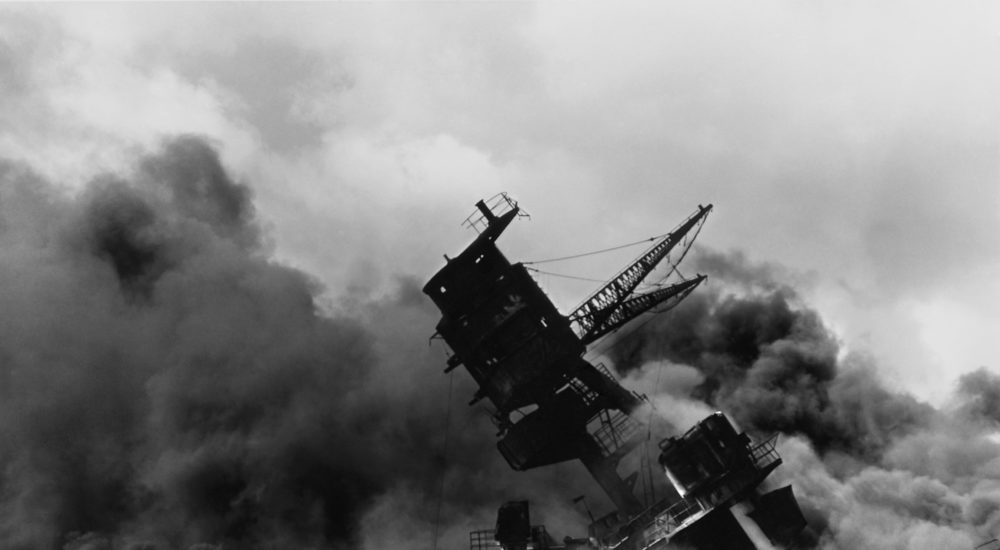Roused from Normalcy: The Home Front on December 7, 1941
[Editor’s note: We are rerunning the late Rick Sincere’s popular Pearl Harbor post from 2017. It has been updated to reflect the years since the attack.]
Eighty-one years ago, an attack on a remote American naval outpost – Pearl Harbor, Hawaii – rousted the United States out of its confidence in its own isolation from the world war that was already two years old.
True, politicians and military leaders were expecting an attack sometime soon. The date and time were unknown, but relations with Japan had deteriorated enough that some kind of assault was considered inevitable.
On the home front, however, people went along in their daily lives, made somewhat nervous by news reports from the war zones. Recovery from the Depression was moving along, although the pre-war growth of defense industries was largely unacknowledged as a stimulant.
Conditions on the home front during World War II have always been fascinating for me, more than the war overseas. This may be because, as a child, the stories I heard from my parents – who were still children in the 1940s – and my grandparents – who did not serve in the Armed Forces – were all about the war at home: ration cards, civil defense drills, shortages of consumer goods, scrap drives. Movies like Woody Allen’s Radio Days or Meg Ryan’s Ithaca pull at me.
So on this anniversary of the Japanese attack on Pearl Harbor, I want to look at the normalcy that was disrupted that Sunday morning. For this, I turn to three historians.
Five years ago, I reviewed a book by Stanley Weintraub called Pearl Harbor Christmas: A World at War, December 1941. Here’s an excerpt:
I picked up Pearl Harbor Christmas by chance at a local bookstore and bought it on a whim, thinking that it primarily would focus on the home front in the weeks following the Pearl Harbor attack and how Americans adjusted their holiday celebrations to the new realities of having been thrust into war.
The book has some of that, and Weintraub is able to draw an adequate picture of what the Christmas season of 1941 was like.
Wartime black-out rules had not yet dimmed Christmas lights, and Christmas trees themselves, Weintraub says, “were plentiful, seldom priced at more than a dollar or two.” Rockefeller Center presented its annual Christmas show, featuring the Rockettes, and people were still reading comic strips and going to the movies.
“The hit book for Christmas giving,” he writes in a prelude, “at a hefty $2.50, was Edna Ferber’s Reconstruction-era romance Saratoga Trunk. For the same price, war turned up distantly yet bombastically in a two-disc set of Tchaikovsky’s 1812 Overture, performed by Artur Rodzinski and the Cleveland Orchestra.”
Weintraub goes on to list the prices of crates of citrus fruits (“$2.79 at Bloomingdales”) and new cars (“soon to be unobtainable”) for $900. Silk stockings were $1.25 a pair, and nylon stockings – which would also quickly disappear as the fabric was needed for parachutes – were $1.65.
In a clever turn of phrase, he writes about upscale clothing shops:
“Hattie Carnegie’s designer dresses began at $15. The upscale Rogers Peet menswear store offered suits and topcoats from a steep $38. (At recruiting stations nationwide, the army was offering smart khaki garb at no cost whatever to enlistees.)”
Craig Shirley, who is best known for his books about Ronald Reagan, wrote December 1941: 31 Days That Changed America and Saved the World. In his chapter on “The Seventh of December” he describes the normal atmosphere that prevailed even in the Hawaiian Islands that day:
Most American newspapers Sunday morning were by and large quiet when it came to the Pacific crisis. The Honolulu Advertiser was covering local news involving housing issues, a display by the Shriners, and the typical international war news coming from Russia, Germany, and England. There was also a special feature on where children could see Santa Claus – from 11:00 a.m. to 5:00 p.m. that day – in front of a fake fireplace in the lobby of the newspaper. Another front-page story reported on the newly formed “Razor Blades for Britain Committee in Hawaii,” which was taking up a collection because blades could no longer be purchased in England as all steel was being devoted to their war effort. “All razor blade donations … must be new,” the story cautioned.
Inside, stories and features favorably reviewed the movie A Yank in the R.A.F.; announced clipper tours between Hawaii, the West Coast, Midway, Wake Island, and the Philippines; and detailed the ongoing prostitution problems on Hawaii.
Note how all those Pacific places would become acutely known in the coming year.
Half a world away, Shirley notes what was going on in the nation’s capital:
In the Washington Star, only one story was devoted to the Far East while the rest of the war and foreign news was about the Russian Front, North Africa, and the North Atlantic. The other news of the day covered sports, the weather, traffic reports, human-interest stories, metro articles, editorials, and columns. The most human of human-interest stories ran across the wires on Sunday morning about the death of a ninety-seven-year-old man, “Ray Fritman, who had spent a lifetime seeking his true identity…. He became lost during a parade in New York in 1852 and never saw his parents again.” He got his name from an orphanage in New York, fought in the Civil War, and later taught school in Indiana.
In God Bless America: Tin Pan Alley Goes to War, a book entirely about the home front (and about an even narrower niche than that), historian Kathleen E.R. Smith of Northwestern State University of Louisiana also writes about the morning of December 7:
Earlier that fall and winter of 1941, when America’s war against Japan had not yet begun, preparations for the holiday season had overshadowed the threat of war. On the first Sunday of December 1941, newspapers carried the usual pre-holiday stories and advertisements. The New York Times filled dozens of pages with gift suggestions. W & J Sloan invited shoppers to visit their “Gay Main Floor” for Christmas presents that ranged from crystal seahorse bookends at $3.95 a pair to a $160.00 coffee table made from a drum used in the War of 1812. The Davega Music Company reminded shoppers of the big sale on Emerson “Miracle Tone” table radios at $34.95. Liberty Music Shop extolled the Deluxe Capehart radio-phonograph as “a time-proved record-changer that turns the record for listeners.” It played twenty records (forty selections) on both sides, providing three hours of uninterrupted music. Prices started at $595.00.
Newspapers weren’t the only medium that revealed more about the normal than the nervous. Smith recounts what the entertainment media had scheduled for the day:
December 7, 1941, began for most Americans as another early winter Sunday morning. Radio programs on the major networks for Sunday afternoon offered a wide choice for the listener: popular music (Sammy Kaye’s Sunday Serenade); drama (Great Play’s version of Inspector General); symphonic music (the New York Philharmonic with guest pianist Artur Rubinstein); pro football (Brooklyn Dodgers vs. New York Giants); and current events (Wake Up America’s panel discussion on “Can There Be a Substantial Reduction in Nondefense Expenditures of the Federal Government?”). And in a twist of irony that would not go unnoticed at the time, on their 5:00 p.m. show the Moylan Sisters planned to sing a favorite tune, “The End of a Perfect Day.”
At the beginning of December 1941, Americans had no idea how long they would be at war. Fortunately, World War II lasted less than four years, unlike the perpetual war that has engaged us after September 2001. Yet, culturally, those four years continue to fascinate and inform us.
Originally published December 7, 2017.





